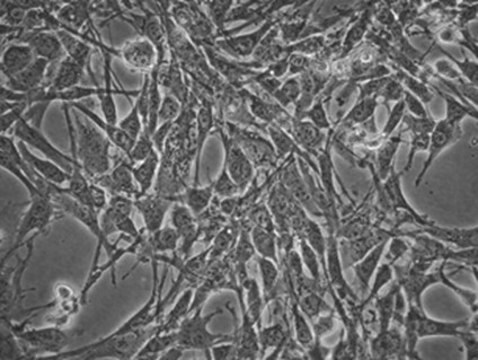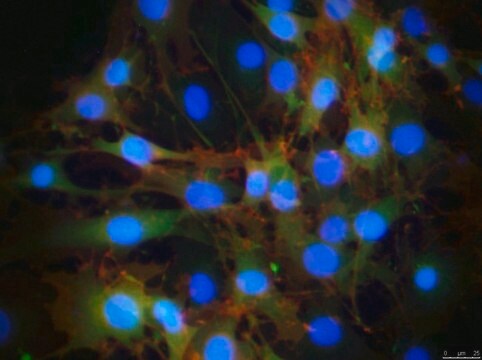SCC167
MS5-hDLL1 Stromal Cell Line
The MS5-mDLL1 stromal cell line is used in a serum-free artificial thymic organoid (ATO) system to generate mature T-cells from human hematopoietic stem and progenitor cells.
Synonym(s):
MS-5-hDLL1
Sign Into View Organizational & Contract Pricing
All Photos(2)
About This Item
UNSPSC Code:
41106514
eCl@ss:
32011203
Recommended Products
biological source
mouse
technique(s)
cell based assay: suitable
cell culture | mammalian: suitable
shipped in
ambient
Related Categories
General description
In vivo, T-cells develop in the thymus from bone-marrow derived hematopoietic stem and progenitor cells (HSPCs). In vitro, various model systems have been employed to mimic thymic function supportive of T-cell development including the OP9-DL1 system. Recently, a serum-free artificial thymic organoid (ATO) system was developed that supports highly efficient and reproducible in vitro differentiation and positive selection of human T-cells from multiple sources of HSPCs, including cord blood, bone marrow and peripheral blood CD34+ HSPCs (Seet et al. 2017). A key component of the ATO system is the MS5-hDLL1 cell line which obviates the need for primary thymic tissues.
To generate the MS5-hDLL1, a murine stromal cell line (MS5) was transduced with a third-generation lentiviral vector encoding human DLL1 and eGFP (Seet et al. 2017). The highest 5% GFP-expressing cells were FACS-sorted and expanded.
To form organoids, MS5-hDLL1 stromal cells are aggregated with HSPCs by centrifugation and cultured on a cell culture insert at the air-fluid interface. Detailed protocols for setting up the artificial thymic organoid (ATO) system are described in reference (Seet et al. 2017).
Reference:
Seet, C.S., He, C., Bethune, M.T., Li, S., Chick, B., Gschweng, E.H., Zhu, Y., Kim, K., Kohn, D.B., Baltimore, D. and Crooks, G.M. (2017) Generation of mature T cells from human hematopoietic stem and progenitor cells in artificial thymic organoids. Nat Methods 14(5): 521-530.
To form organoids, MS5-hDLL1 stromal cells are aggregated with HSPCs by centrifugation and cultured on a cell culture insert at the air-fluid interface. Detailed protocols for setting up the artificial thymic organoid (ATO) system are described in reference (Seet et al. 2017).
Reference:
Seet, C.S., He, C., Bethune, M.T., Li, S., Chick, B., Gschweng, E.H., Zhu, Y., Kim, K., Kohn, D.B., Baltimore, D. and Crooks, G.M. (2017) Generation of mature T cells from human hematopoietic stem and progenitor cells in artificial thymic organoids. Nat Methods 14(5): 521-530.
Cell Line Description
Stromal Cells
Application
Research Category
Immune Response
Inflammation & Immunology
Immune Response
Inflammation & Immunology
The MS5-mDLL1 stromal cell line is used in a serum-free artificial thymic organoid (ATO) system to generate mature T-cells from human hematopoietic stem and progenitor cells.
This product is intended for sale and sold solely to academic institutions for internal academic research use per the terms of the “Academic Use Agreement” as detailed in the product documentation. For information regarding any other use, please contact licensing@emdmillipore.com.
Quality
• Each vial contains ≥1X10⁶ viable cells.
• Cells are tested negative for infectious diseases by a Mouse Essential CLEAR panel by Charles River Animal Diagnostic Services.
• Cells are verified to be of mouse origin and negative for inter-species contamination from rat, chinese hamster, Golden Syrian hamster, human and non-human primate (NHP) as assessed by a Contamination Clear panel by Charles River Animal Diagnostic Services.
• Cells are negative for mycoplasma contamination.
• Cells are tested negative for infectious diseases by a Mouse Essential CLEAR panel by Charles River Animal Diagnostic Services.
• Cells are verified to be of mouse origin and negative for inter-species contamination from rat, chinese hamster, Golden Syrian hamster, human and non-human primate (NHP) as assessed by a Contamination Clear panel by Charles River Animal Diagnostic Services.
• Cells are negative for mycoplasma contamination.
Storage and Stability
Store in liquid nitrogen. The cells can be cultured for at least 10 passages after initial thawing without significantly affecting the cell marker expression and functionality.
Disclaimer
This product contains genetically modified organisms (GMO). Within the EU GMOs are regulated by Directives 2001/18/EC and 2009/41/EC of the European Parliament and of the Council and their national implementation in the member States respectively. This legislation obliges {HCompany} to request certain information about you and the establishment where the GMOs are being handled. Click here for Enduser Declaration (EUD) Form.
Unless otherwise stated in our catalog or other company documentation accompanying the product(s), our products are intended for research use only and are not to be used for any other purpose, which includes but is not limited to, unauthorized commercial uses, in vitro diagnostic uses, ex vivo or in vivo therapeutic uses or any type of consumption or application to humans or animals.
Unless otherwise stated in our catalog or other company documentation accompanying the product(s), our products are intended for research use only and are not to be used for any other purpose, which includes but is not limited to, unauthorized commercial uses, in vitro diagnostic uses, ex vivo or in vivo therapeutic uses or any type of consumption or application to humans or animals.
Storage Class
12 - Non Combustible Liquids
wgk_germany
WGK 1
flash_point_f
does not flash
flash_point_c
does not flash
Certificates of Analysis (COA)
Search for Certificates of Analysis (COA) by entering the products Lot/Batch Number. Lot and Batch Numbers can be found on a product’s label following the words ‘Lot’ or ‘Batch’.
Already Own This Product?
Find documentation for the products that you have recently purchased in the Document Library.
Our team of scientists has experience in all areas of research including Life Science, Material Science, Chemical Synthesis, Chromatography, Analytical and many others.
Contact Technical Service






